|
1.Postgraduate Institute of Medical Education and Research (PGIMER), Chandhigarh
https://pgimer.edu.in/PGIMER_PORTAL/PGIMERPORTAL/home.jsp
|
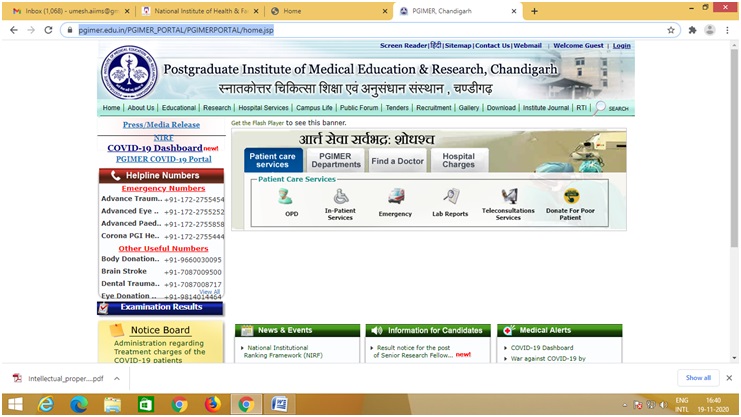 |
https://elibpgimer.remotexs.in/
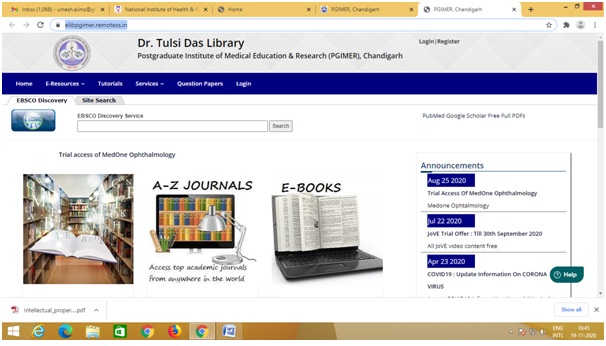
|
|
Mandate
The Postgraduate Institute of Medical Education and Research (PGIMER)Chandigarh was conceived in 1960 as a center of excellence which would endeavour to develop patterns of teaching in postgraduate medical education in as many branches as possible and attempt to produce specialists in several disciplines of medicine. It was also envisaged that these specialists would spread out in the country in various medical colleges and medical institutions and impart medical education of highest standard to the students and set up nucleus of excellence in their own institutions. The PGIMER was also given the responsibility to broaden the horizons of medical knowledge by intensive research in the field of health.
Prime Minister Pandit Jawahar Lal Nehru inaugurating the Nehru Hospital on 7th July 1963.
|
|
Brief History
The PGIMER owes its inception to the vision of late Sardar Partap Singh Kairon, the then Chief Minister of Punjab and the distinguished medical educationists of the then combined state of Punjab, supported by the first Prime Minister of India Pt. Jawahar Lal Nehru who considered the institutions of scientific knowledge as temples of learning and the places of pilgrimage. The institute started in 1962 and Pt Jawahar Lal Nehru inaugurated the hospital now named “Nehru Hospital” on 7th July 1963. The Institute was originally under the Government of undivided Punjab. After the reorganization of the state, the administrative control of the institute passed on to the Union Territory of Chandigarh in November 1966. The Institute became an autonomous body under the Act of Parliament in 1967 functioning under the Ministry of Health and Family Welfare, Government of India, with the following mandate.
|
-
Provide high quality patient care.
-
Attain self-sufficiency in postgraduate medical education and to meet the country’s need for highly qualified medical teachers in all medical and surgical fields.
-
Provide educational facilities for the training of personnel in all-important branches of health activity.
-
Undertake basic community based research.
-
The founders of this Institute Prof. Tulsi Das, Prof. Santokh Singh Anand, Prof. PN Chuttani, Prof. BN Aikat, Prof. Sant Ram Dhall and Prof. Bala Krishna laid the path of excellence for the Institute.
|
|
|
2. Sanjay Gandhi Post Graduate Institute of Medical Sciences (SGPGIMS) Lucknow
(http://www.sgpgi.ac.in/)
|
|
http://www.sgpgi.ac.in/
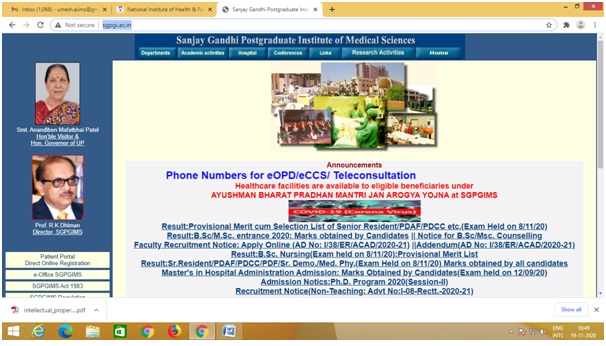
|
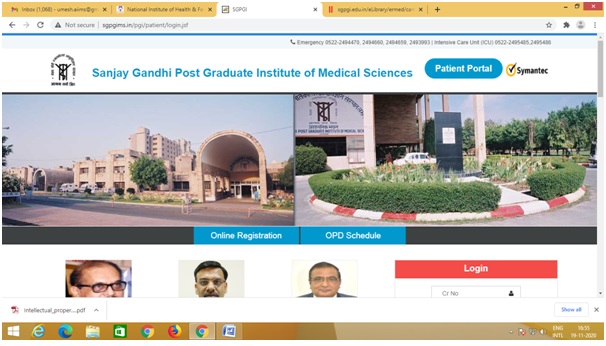 |
|
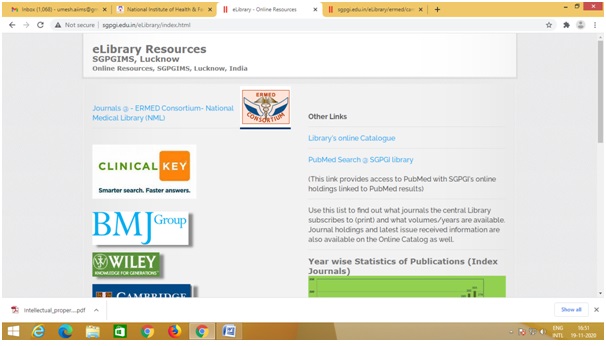
|
|
Sanjay Gandhi Post Graduate Institute of Medical Sciences, Lucknow, is a Super-Speciality teaching and training Medical Institution, situated to the Southeast of Lucknow city on Lucknow-Raebareli Road, and is nearly 12 Km from the main (Charbagh) railway station, Lucknow Airport and city cente(Hazratganj). From the railway station, private buses (route 3) run to the Institute at short intervals. Alternatively, pre-paid auto-rickshaws taxis are also available for travel to the Institute. The hospital is located nearly 1 Km from the Institute main gate and a regular free shuttle bus makes a to-and-fro trip every 10-15 minutes. The Institute has 1050 beds, including 146 intensive/high dependency beds. It has 24 operationtheaters with state of art facilities. It runs 115outpatient clinics of different specialties every week.
|
|
3. National Institute of Health and Family Welfare (NIHFW),
http://www.nihfw.org/index.html
|
|
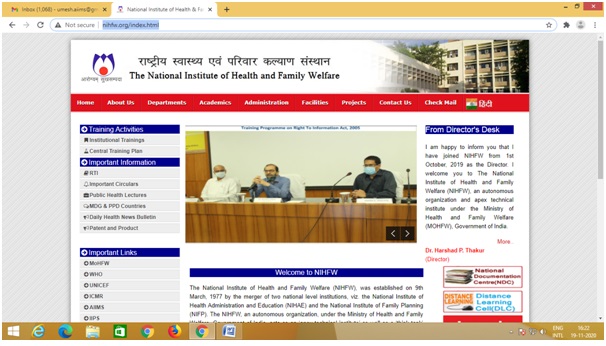
|
|
The National Institute of Health and Family Welfare (NIHFW), was established on 9th March, 1977 by the merger of two national level institutions, viz. the National Institute of Health Administration and Education (NIHAE) and the National Institute of Family Planning (NIFP). The NIHFW, an autonomous organization, under the Ministry of Health and Family Welfare, Government of India, acts as an ‘apex technical institute’ as well as a ‘think tank’ for the promotion of health and family welfare programmes in the country.
|
|
4. INDIAN COUNCIL OF MEDICAL RESEARCH
https://www.icmr.gov.in/
|
|
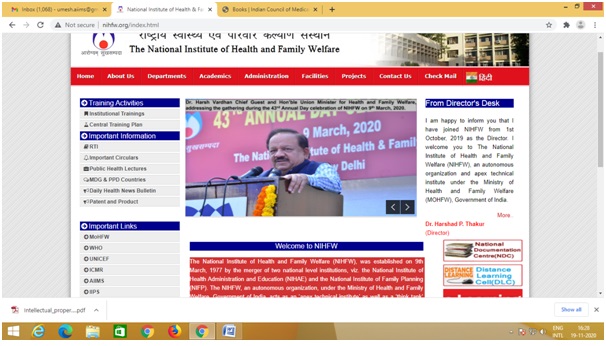
|
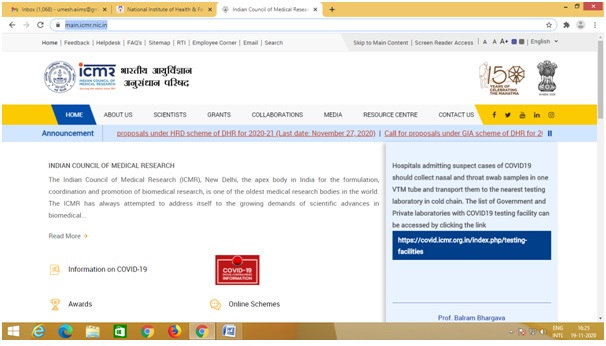
|
|
The Indian Council of Medical Research (ICMR), New Delhi, the apex body in India for the formulation, coordination and promotion of biomedical research, is one of the oldest medical research bodies in the world.
The ICMR has always attempted to address itself to the growing demands of scientific advances in biomedical research on the one hand, and to the need of finding practical solutions to the health problems of the country, on the other. The ICMR has come a long way from the days when it was known as the IRFA, but the Council is conscious of the fact that it still has miles to go in pursuit of scientific achievements as well as health targets.
|
|
5.Christian Medical College, Vellore, Tamilnadu
https://www.cmch-vellore.edu/www.cmch-vellore.edu https://www.cmch-vellore.edu/Departments.aspx?depttype=ALL
|
|
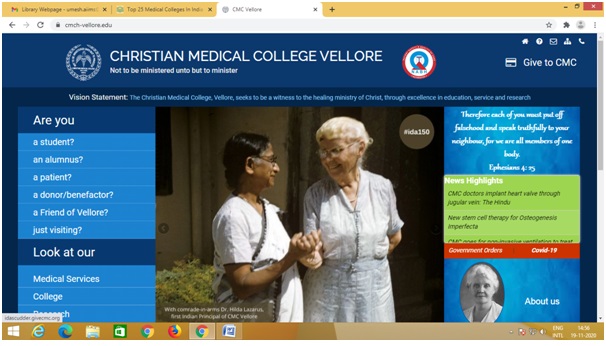
|
https://www.cmch-vellore.edu/Departments.aspx?depttype=ALL
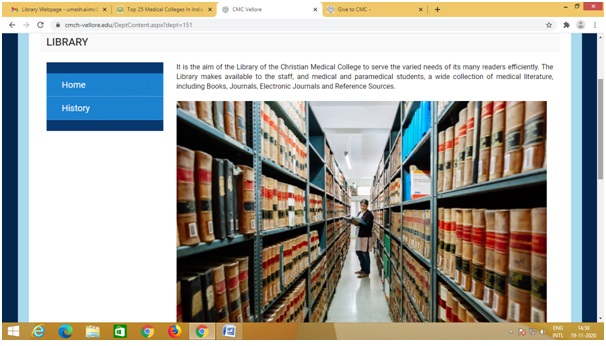
|
|
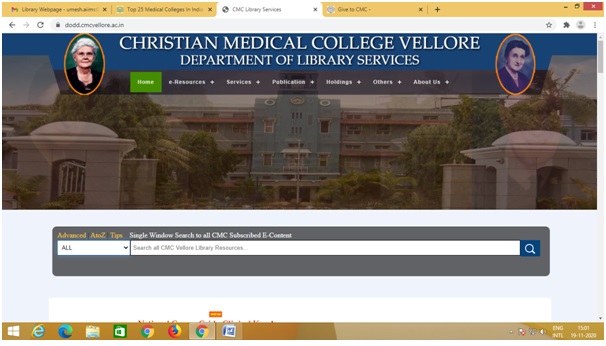
|
|
Know your Department -Library Services Genesis: The services of the Department of Library started its humble beginning in the Department of Nuclear Medicine at the Hospital campus with very limited books and journals in the year 1940. Gertrude Dodd was attracted by the mission work of Dr. Ida Scudder and left the comforts of her home to join Dr. Ida and served here for three decades. Therefore the Library has been aptly named as Dodd Memorial Library in honour of her dedicated service. The Library witnessed a swift and significant development each year ever since its nascent stage since 1940. 1942: The collection of faculty publications began at the library which was followed by the introduction of the Monthly Index Medicus and Cumulative Comprehensive Index Bibliographic Tools to locate the articles. 1947: Establishment of the Microfilm Service Unit 1965: Relocation of the hospital library building to the second floor of the OPD building. 1987: Introduction of the Reprographic Facility with a new Panaprint Copycat Xerox Machine ECX303 Mark II which was later replaced with Zoom Modi Xerox Machine. 1981: Members were allowed to carry their personal books to the library; CMC being the first of its kind to introduce such a measure. 1989: Relocation of the College Hill Library to its present location. The library was renamed as the “Gault Library” in memory of the Pathologist Dr. Edward Gault. 1989-1991: Installation of ‘Medline’, the National Library of Medicine (NLM) bibliographic database on CD / ROM and later a Video Unit. 1992: Relocation of The Dodd Memorial Library which was housed in the 2nd Floor of OPD Block to the 1st and 2nd Floor of the ASHA Educational Building. 1998: Extension of the Internet and Email Facility at Dodd Memorial Library. 2002: Introduction of the Electronic Journal Access and Wifi . 2005-2008: Introduction of Computer laboratories in both the Dodd and Gault libraries and usage of Barcoded Identity cards for the whole CMC Students Community. 2008: Introduction of E-resources through EZ-proxy by the off-campus online access for assisting the faculty travelling out of station and to the Mission Hospitals to acces the network . 2010: Installation of surveillance cameras. 2016: This year saw a significant milestone in the developments of the libraries. The Radio Frequency Identification (RFID) system was introduced. The application of Information Communication Technology (ICT) has brought dramatic changes in the library services. The library website was integrated with LinkOut, a unique service that allows direct links from PubMed. This gives a count of full text articles available in CMC portal apart from PubMed central which is a free full text database of NLM, USA. P.T.O Madam Gertrude Dodd Dr. Edward Gault There has been a voluminous growth of published documents in the recent past. By using Dspace software the library has taken the effort to collect all the published articles with the full text and the Inter Library Loan system was introduced and MoUs signed with DELNET, New Delhi, Q-Med Knowledge Foundation, Mumbai, to avail the unavailable articles. The Online Public Catalogue Access (OPAC) is an additional feature of the library service. Electronic resources like e-books, e-journals and databases were introduced eventually. Besides the main libraries, resources are procured from more than 50 departmental libraries, with proper inventories. The library provides statistical data to all the Inspection agencies like MCI, Tamil Nadu Dr.MGR Medical University, and other National, Regional and State level agencies. Data is also provided to the media of the country which involves in National Ranking of the Institutes. The department has also been quite busy with organising various academic events. Three remarkable workshops and conferences at regional and international level were organised. A workshop on Greenstone Digital Library in 2007, a regional conference on “Scientific Writing” in 2015 and an international conference on Libraries Beyond Borders” in 2017. A pre-conference proceeding with ISBN was published during the International conference. Library services are open till midnight with access to all services. There is no doubt that the CMC Libraries provide a conducive environment for education and research. The staff in the library is well equipped to serve the readers and thus joining hands in fulfilling the great vision of the founder Dr.Ida Sophia Scudder in building the kingdom of God by supporting education, research and patient care.
|
|
6. Armed Forces Medical College (AFMC) – Pune, MAHARASTRA
www.afmc.nic.in
|
|
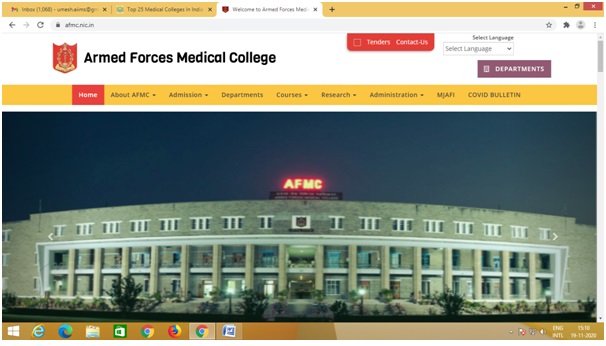
|
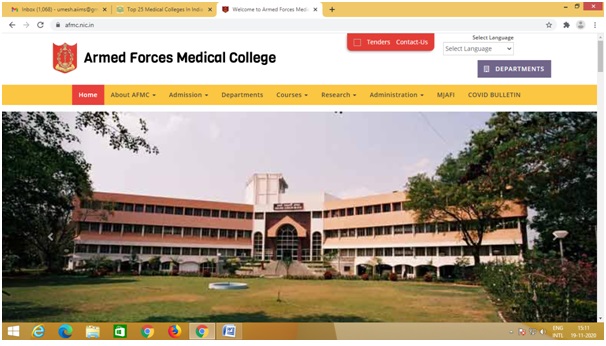
|
|
Armed Forces Medical College
Armed Forces Medical College is a premier medical institute of India acknowledged as a centre of excellence for education and research. The college provides training to under-graduate and post-graduate medical and nursing students with assured career prospects in the defence services.
The institute was set up on 01 May 1948 by the recommendations of the BC Roy Committee by the amalgamation of various defence medical organizations. The "Graduate Wing" of AFMC was established on 04 August 1962 to provide a sustainable and steady intake of medical officers for the Indian Armed Forces. The institute is presently affiliated to the Maharashtra University of Health Sciences and is recognized by the MCI for conducting undergraduate and various post graduate medical courses.
|
|
7. Jawaharlal Institute of Postgraduate Medical Education and Research , Puducherry
www.jipmer.edu.in
|
|
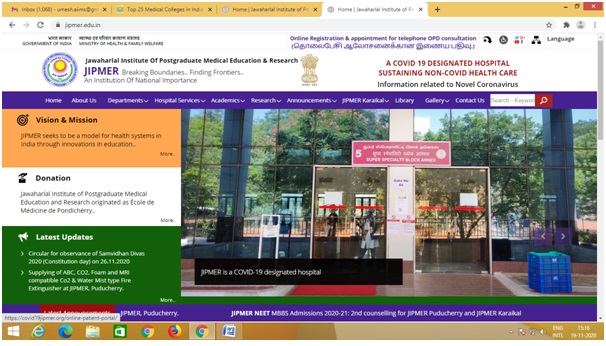
|
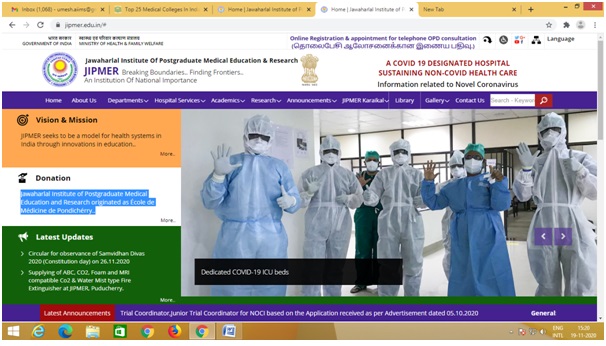
|
|
JIPMER
Jawaharlal Institute of Postgraduate Medical Education and Research (JIPMER) can trace its origins to the ‘Ecole de Medicine de Pondicherry’ established by the French Government in 1823. In 1956 foundation for new medical college was laid and in 1964, hospital was inaugurated. JIPMER became an institution of national importance under the Ministry of Health and Family Welfare, Government of India in the year 2008. It is an institution established for teaching, research and patient care in the area of health. JIPMER spreads over 192 acres. The institution houses one administrative block, one academic centre, one nursing college, seven hospital blocks, seven accessory services buildings and four residential complexes. 12 broad types of medical, nursing and allied health science courses covering all disciplines in healthcare from basic to super speciality training are conducted.
JIPMER is one among the very few institutions in the country which is providing teaching from undergraduate to superspeciality & sub-specialties, conducting path breaking research and providing specialty care of high order. The model of providing free specialty health care while maintaining quality and safety makes JIPMER a unique model in the country. JIPMER’s success in providing best treatment even to the least affordable in the society makes it a model of speciality care delivery of the future. JIPMER continues to rank among the top best five medical schools in the country. JIPMER is witnessing expansion in the form of new campuses like JIPMER Karaikkal, JIPMER outreach centre at Yanam apart from the soon to be commissioned screening OPD block and superspeciality extention block. Conceptual plans for Puducherry second campus for Institute of organ transplantation and Institute of advanced trauma and rehabilitation were initiated during this period.
|
|
8. Maulana Azad Medical College (MAMC) - New Delhi
www.mamc.ac.in
|
|
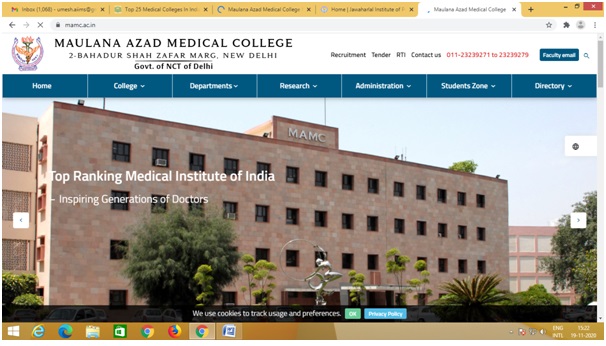
|
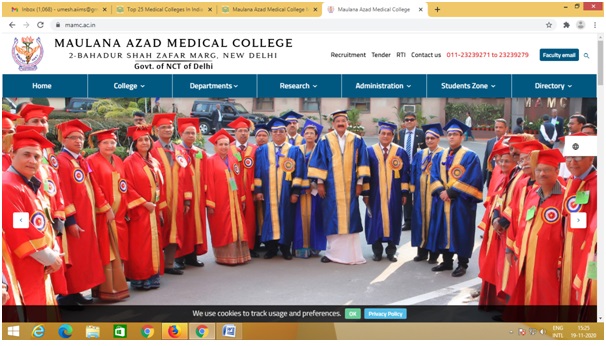
|
|
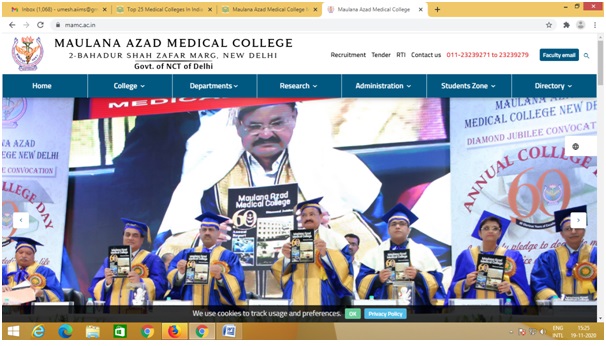
|
|
9.Lady Hardinge Medical College (LHMC) - New Delhi
http://lhmc-hosp.gov.in/ ,http://lhmc-hosp.gov.in/index.php
|
|
http://lhmc-hosp.gov.in/index1.php?lang=1&level=1&sublinkid=27&lid=77
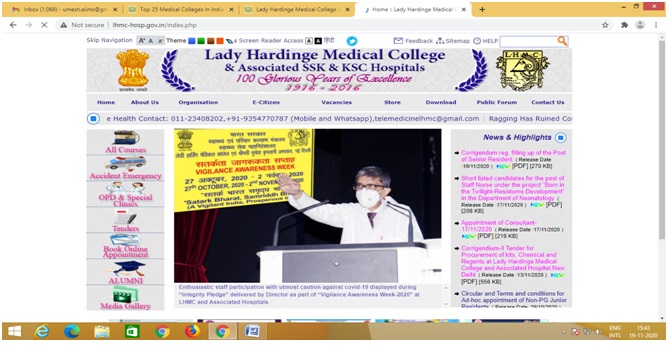
|
|
History
The Lady Hardinge Medical College for women was founded in 1914 to commemorate the visit of Her Majesty Queen Mary in 1911-12. Lady Hardinge the wife of the then Viceroy was the first to take initiative for starting a medical college for women, as the lack of separate medical college for women made it almost impossible for Indian women to study medicine.
The foundation stone of this institution was laid by Lady Hardinge on 17th March, 1914. Unfortunately this great lady died later in the same year and on the suggestion of Queen Mary the college and the hospital was named after Lady Hardinge to perpetuate the memory of its founder.
The college and hospital was formally opened by Lord Hardinge the then Viceroy of India on 17th February 1916. The close association of countess of Dufferin Fund Council continued over many years and senior teaching staff almost exclusively consisted of its members till India became independent.
The college started under the able leadership of Dr. Kate Platt, who was the first Principal of the college. The duration of course covered a period of 7 years including 2 years of pre-medical intermediate science course or Punjab University. The premedical science departments were closed in 1935, thus reducing the course in the college from 7 years to 5 years. In 1960 rotating internship was introduced for 6 months. The MBBS course was reduced from 5 years to 4 1/2 years in 1969 compulsory internship of one year was introduced.
The number of admissions to the first year was increased gradually from 16 per year in 1916 to 60 in 1956. In 1961 the admissions were increased to 100 and were further raised to 130 in 1970. To implement the Central Educational Institution (Reservation In Admission) Act 2006 LHMC increased under graduate admissions to 150 in 2008 and now 200 under grading and advanced equerry year.
Since 1950, the college has been affiliated to University of Delhi. Post-graduate courses were started in 1954 in affiliation with Punjab University and later on with University of Delhi in 1956. To start with only female post-graduate students were admitted, but since 1970 both males and female students are being enrolled for various postgraduate courses. Presently LHMC is admitting 142 PG candidates, 4 seats of MCH Pediatric Surgery and 4 seats of DM Neonatology.
Starting in 1916 with only 80 beds for the departments of Medicine, Obstetrics and Gynaecology, LHMC has now bed strength of 877 beds in Smt. S.K. Hospital and 377 beds in Kalawati Saran Children Hospital. A separate outpatient block was started in 1958 to cater to the needs of ever increasing population of Delhi.
Kalawati Saran Children Hospital was established on 17th March 1956 as a center of excellence in pediatric care and research. At the outset it had only 50 beds, gradually by 1994 the bed strength was increased to 350 and presently there are 377 beds in KSCH. It has the largest Neonatal wing in Delhi with 84 beds. The opening of Indo-Japan new block has augmented various medical facilities for the patients.
Training school for nurses started modestly in 1916 with 11 probationers admitted to the school every year. The school was further expanded to admit 50 students. The School was upgraded to Nursing College of Nursing 2007.
Director's Desk
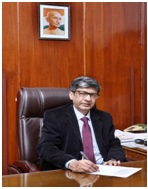
Dr (Prof) N N Mathur MS DNB FAMS
Director & Additional DGHS & Director Professor (ENT)
Lady Hardinge Medical College
& Smt Sucheta Kriplani and Kalawati Saran Children's Hospital
Lady Hardinge Medical College, which is one of India’s oldest and established medical college, is undergoing a major infrastructural change under Comprehensive Redevelopment Project to meet the modern day health needs of the patients and educational needs of the students studying here. This Medical and Nursing College was the first Medical College to be built in Delhi soon after it became the capital on being shifted from Calcutta in 1912. The foundation stone of the college was laid on 17th March 1914 and the college started in 1916. During these many years the college has produced thousands of medical graduates, postgraduates and nursing graduates and trained doctors who have contributed immensely in the field of medicine in the country and abroad.
The college has always maintained very high standards of education and therefore it is in the fitness of things that we work to provide the much-awaited highest level of infrastructure and facilities to the faculty, students, doctors, nurses and all types of health care personnel working in the College and its associated Smt Sucheta Kriplani and Kalawati Saran Children’s Hospital. We are in the middle of Phase One of the redevelopment activity and hope to achieve the new redevelopment targets in time or even before. At the completion of all phases of redevelopment in near future, we hope to have a completely modern campus.
We also plan to increase the intake of postgraduate students and also introduce new post-doctoral courses as we add new infrastructure and employ more faculty.
Jai Hind.
|
|
10.Madras Medical College Chennai , TAMILNADU
http://www.mmc.ac.in/mmc/
|
|
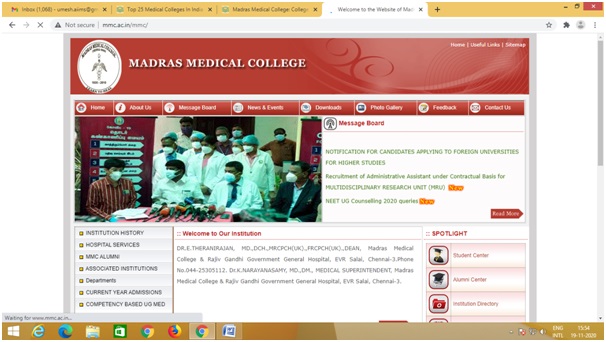
|
|
INSTITUTION HISTORY : Institution History
|
|
The Government General Hospital, one of the premier Institutions in the country was started on 16th November 1664 as a small Hospital to treat the sick soldiers of the East India Company. It was the untiring inspired efforts of Sir Edward Winter who was the agent of the company that materialised in the first British Hospital at Madras.
In its early days the Hospital was housed at the Fort St. George and in the next 25 years grew into a formal medical facility. Governor Sir. Elihy Yale was instrumental in the development of the Hospital and gave it a new premises with in the Fort in 1690.
The Hospital moved out of the Fort after the Anglo French War and it took 20 long years before it could settle in the present permanent place in 1772. By the year 1772 the Hospital was training Europeans, Eurasians and natives in allopathic methods of diagnosis and treatment and methods of preparing medicines. These trained personnel's were posted to various dispensaries in the district head quarters of the then Madras Presidency to assist the qualified doctors. By 1820 the institution had the recognition as the model hospital of the East India Company. So in 1827 Dr. D.Mortimar was appointed as the Superintendent of the Hospital.
A private medical hall run by Dr. Mortimar was regularised as a medical school and it was opened by Sir Fredrick Adams, the then Governor of Madras on 2nd February 1835. The Governor promulgated an order to make the school a state sponsored one and attached it to the General Hospital.
In 1842 the Hospital opened its doors to Indians. In the next two decades, the teaching staff had increased, the duration of the course extended and the curriculum was made comprehensive. Senior courses spanning 5 years was started and private people were also admitted for the first time in the institution. In the early part of 1850 the school council submitted proposals to the government to accord the status of a College. The Government granted this request and from 1st October 1850 it became Madras Medical College.
The first batch of students graduated in 1852 and were granted the Diploma of Graduate of the Madras Medical College. In 1857, it gained affiliation to the University of Madras. After the affiliation in 1857 the College moved to be a center of excellence imparting training in all the specialities in the field of medicine and surgery and it is now one of the premier institutions in the country with under graduate, post graduate and super speciality courses.
The Courses offered by the Madras Medical College are affiliated from 1988 to the “The Tamilnadu Dr. MGR Medical University” This College has nine affiliated institutions with hospitals, each one of them recognized for excellence in Health care services. This College stands with pride for having produced Doyens in the field of Medicine and forget not that you have become a part of this great institution now
|
|
|
11.Grant Govt Medical College & Sir JJ Group of Hospitals – Mumbai Maharashtra
www.gmcjjh.org ,https://ggmcjjh.com/
|
|
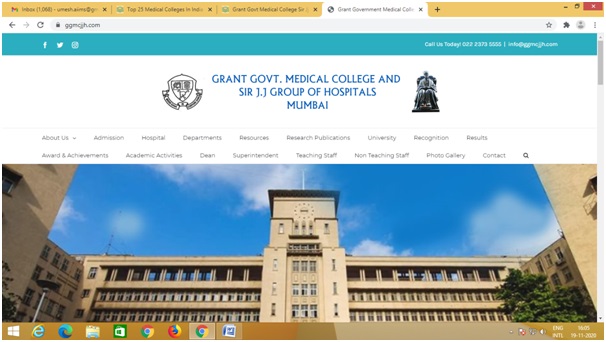
|
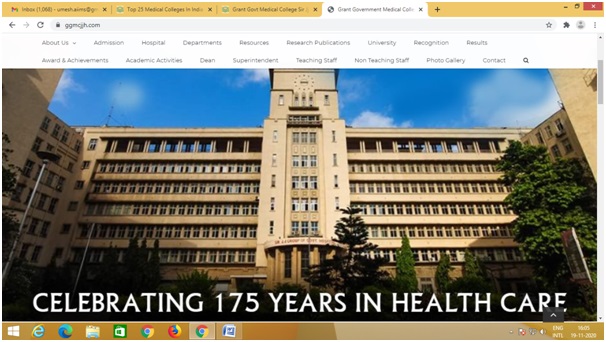
|
Preamble of college
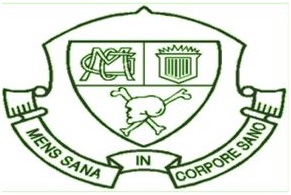
|
|
INTRODUCTION
Grant Govt. Medical College & Sir J. J. Group of Hospitals Mumbai stands apart amongst all the medical colleges in Maharashtra because of its unique topography, connectivity and persistent leadership in medical training and health care for common man over the past one and a half-century.
Grant Medical College & Sir J. J. Group of Hospitals Mumbai is a premier and pioneer medical institution of 175 years of existence. This oldest medical institution run by the Government of Maharashtra providing undergraduate and postgraduate medical training and health care ranging from specialties to super-specialties along with tertiary care to patients will provide enhanced standards of medical education and health care.
Grant Medical College & Sir J. J. Group of Hospitals has situated the territory of south and central Mumbai. Mumbai is well connected by Western and Central railway, roadways, and airways and even by sea from all the parts of Maharashtra, India & the world.
Because of its better connectivity, people from many parts of the country find Mumbai convenient and also well equipped for treatment. Free and quality treatment across a large number of specialties for people below the poverty line and at a nominal cost to the common man is another important reason of getting an inflow of poor patients from grossly deficient and underdeveloped regions of the state and the country to Grant Medical College & Sir J. J. Group of Hospitals.
HISTORICAL BACKGROUND
Grant Govt. Medical College a premier medical institution and Sir J. J. Group of hospitals (including the other 3 attached hospitals) a tertiary care center, both of 175 years heritage are under the auspices of Govt. of Maharashtra.
The British administration of the Bombay Presidency started a medical school in 1826, but it prematurely closed after 6 years of its inception.
In 1835, Sir Robert Grant, the then Governor of Bombay visualized a systematic and scientific institution in Bombay for imparting comprehensive health care and medical training. The foundation stone of Grant Medical College was laid on 30th March 1843 and it was opened on 1st Nov. 1845 admitting the first batch of eight students.
Sir Jamshetjee Jejeebhoy came forward with a donation of rupees one lakh for the establishment of a hospital, as clinical medicine cannot be learned in the classrooms, but by the actual treatment of the patients who are admitted to the hospital attached to the medical college. The foundation stone of Sir J.J.Hospital was laid on 3rd Jan 1843 and the inauguration took place on 15th Mary 1845. Later many philanthropists gave a handsome donation to develop various departments that formed Sir J.J.Group of Hospital as it stands today.
Over last 175 years, Grant Medical College has produced a galaxy of eminent doctors and medical teachers & made its place on the world map.
|
|
|
|
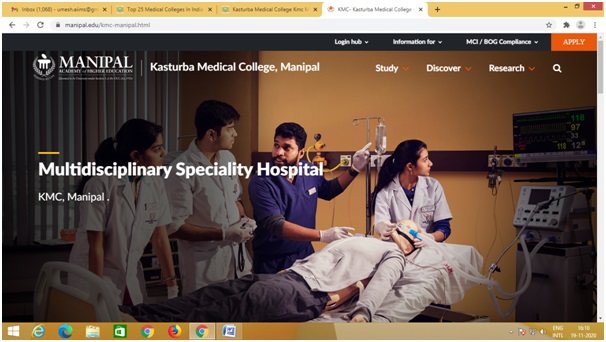
|
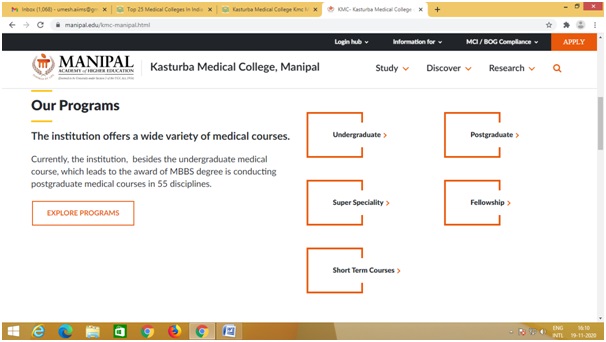
|
13.Sri Ramachandra Medical College & Research Institute (SRMC) - Chennai , TAMILNADU
www.sriramachandra.edu.in
|
|
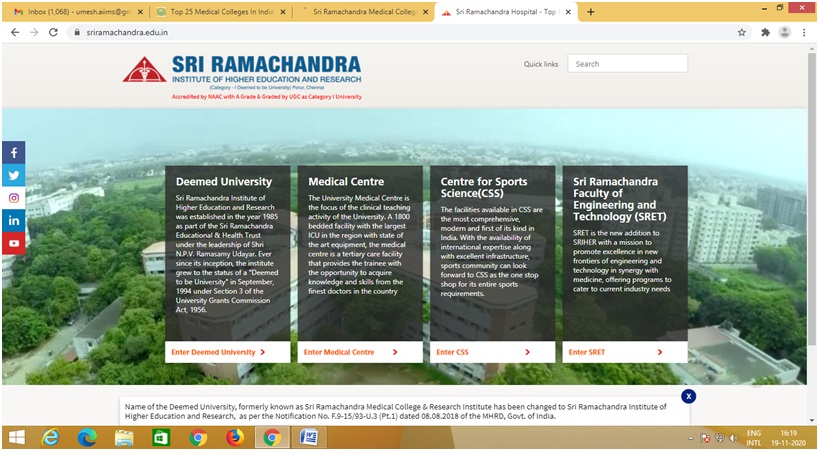
|































